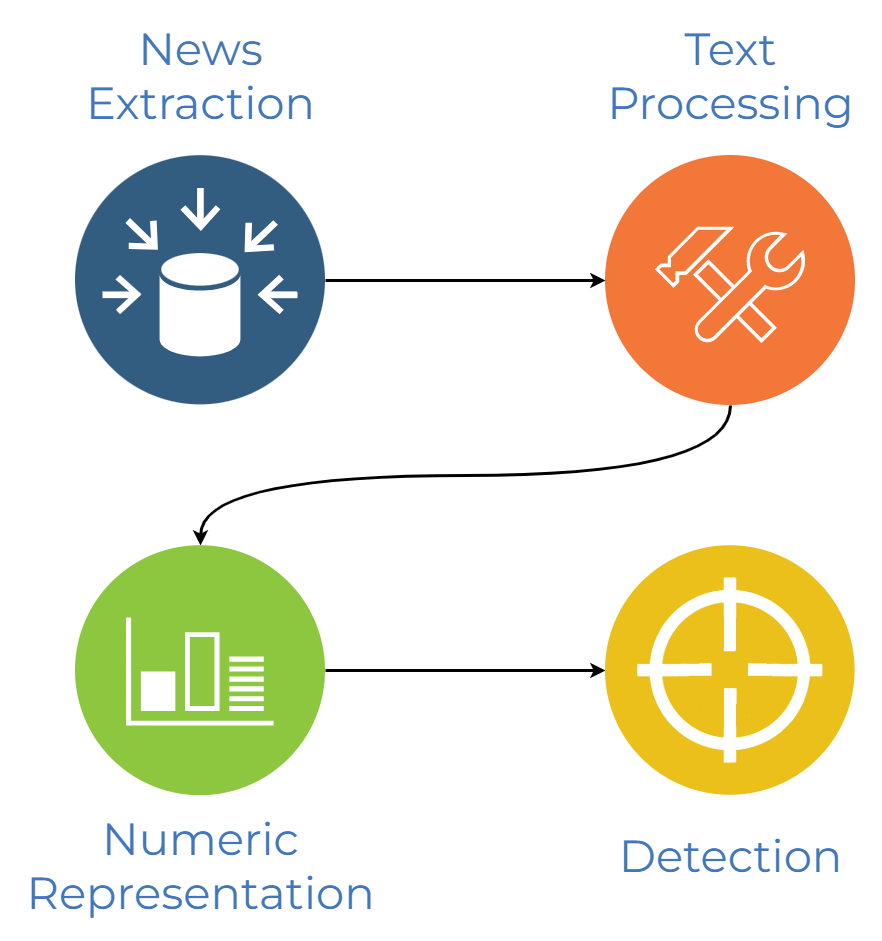Detección Automática de Noticias Falsas en Español: Sátira Política Ecuatoriana
##plugins.themes.bootstrap3.article.main##
Resumen
La circulación de noticias falsas en internet, especialmente las de sátira política a través de redes sociales, ha afectado a la mayoría de la población ecuatoriana. Este trabajo presenta una metodología basada en el aprendizaje estadístico que detecta de forma precisa y automática noticias falsas en español utilizando técnicas de aprendizaje automático y procesamiento del lenguaje natural. El documento comienza presentando conceptos básicos relacionados con las noticias falsas y trabajos relacionados con su detección automática. La segunda sección explica el proceso de creación del corpus de noticias, procesamiento de los textos, representación numérica con TF-IDF y entrenamiento de algoritmos de clasificación supervisados con dos conjuntos de datos diferentes. Los resultados obtenidos del entrenamiento se analizan en la tercera sección, siendo los modelos con máquinas de soporte vectorial los que ofrecen mejores predicciones, mejorando aproximadamente un 15%, 6% y 3% al rendimiento de los modelos con naive bayes, random forests y árboles boosting respectivamente. Finalmente, las conclusiones de la investigación y el trabajo futuro se presentan en la cuarta sección.
Descargas
Descargas
Detalles del artículo
Citas
Allcott, H. and Gentzkow, M. (2017). Social Media and Fake News in the 2016 Election Journal of Economic Perspectives (31), 211-236. https://doi.org/10.1257/jep.31.2.211
Bergström, A. and Jervelycke Belfrage,M.(2018).News in Social Media:Incidental consumption and the role of opinion leaders. Digital Journalism(6),1-16.http://dx.doi.org/10.1080/21670811.2018.1423625
Bondielli, A. and Marcelloni, F. (2019). A Survey on Fake Newsand Rumour Detection Techniques. Information Sciences (497),38-55. https://doi.org/10.1016/j.ins.2019.05.035
Bowyer, K., Chawla, N., Hall, L., Kegelmeyer, W. (2011).SMOTE: Synthetic Minority Over-sampling TechniqueJ. Artif.Intell. Res. (JAIR)(16), 321-357. https://doi.org/10.1613/jair.953
Ciampaglia, G., Shiralkar, P., Rocha, L., Bollen, J., Menczer, F., Flammini, A. (2015). Computational Fact Checking from Knowledge Networks. PloS one(10).http://dx.doi.org/10.1371/journal.pone.0128193
Lazer, D., Baum, M., Benkler, Y., Berinsky, A., Greenhill, K.,Menczer, F., Metzger, M., Nyhan, B., Pennycook, G., Rothschild, D., Schudson, M., Sloman, S., Sunstein, C., Thorson, E., Watts,D., Zittrain, J. (2018). The science of fake news. Science(359),1094-1096. http://dx.doi.org/10.1126/science.aao2998
López-Borrull, A., Vives-Gràcia, J. and Badell, J. (2018). Fakenews, ¿amenaza u oportunidad para los profesionales de la información y la documentación?El Profesional de la Información(27), 1346. http://dx.doi.org/10.3145/epi.2018.nov.17
Posadas Durán, J., Gomez Adorno, H., Sidorov, G., Moreno, J.(2019). Detection of fake news in a new corpus for the Spanish language. Journal of Intelligent & Fuzzy Systems(36), 4869-4876.http://dx.doi.org/10.3233/JIFS-179034
Pedregosa, F., Varoquaux, G., Gramfort, A., Michel, V., Thirion,B., Grisel, O., Blondel, M., Prettenhofer, P., Weiss, R., Dubourg,V., Vanderplas, J., Passos, A., Cournapeau, D., Brucher, M., Per-rot, M., Duchesnay, E. (2011). Scikit-learn: Machine Learning inPython. Journal of Machine Learning Research (12), 2825-2830.
Pulido CM, Ruiz-Eugenio L, Redondo-Sama G, Villarejo-Carballido B. (2020). A New Application of Social Impact in Social Media for Overcoming Fake News in Health. Internationaljournal of environmental research and public health(17), 2430.http://dx.doi.org/10.3390/ijerph17072430
Shelomi, M. Opinion: Using Pokémon to Detect Scientific Misinformation. Obtained from: https://www.the-scientist.com/.(November, 2020).
Singhania S., Fernandez N., Rao S. (2017). 3HAN: A Deep Neural Network for Fake News Detection. Neural Information Processing. ICONIP 2017. Lecture Notes in Computer Science(10635).
Soll, J. The Long and Brutal History of Fake News: Bo-gus news has been around a lot longer than real news. And it’s left a lot of destruction behind. Obtained from:https://www.politico.com/magazine/. (November, 2016).
Vajjala, S., Majumder, B., Gupta, A., Surana, H. (2020). PracticalNatural Language Processing.
Zhang, X. and Ghorbani, A. (2020). An overview of on-line fake news: Characterization, detection, and discussion. Information Processing & Management(57), 102025.https://doi.org/10.1016/j.ipm.2019.03.0045
Zhou, X. and Zafarani, R. (2020). A Survey of Fake News: Fundamental Theories, Detection Methods, and Opportunities. ACM Comput. Surv.(53), 40. https://doi.org/10.1145/3395046




